Vegan Matcha Macarons
Hello friends, let’s make Vegan Matcha Macarons today! Have you ever tried Green Tea Macarons?
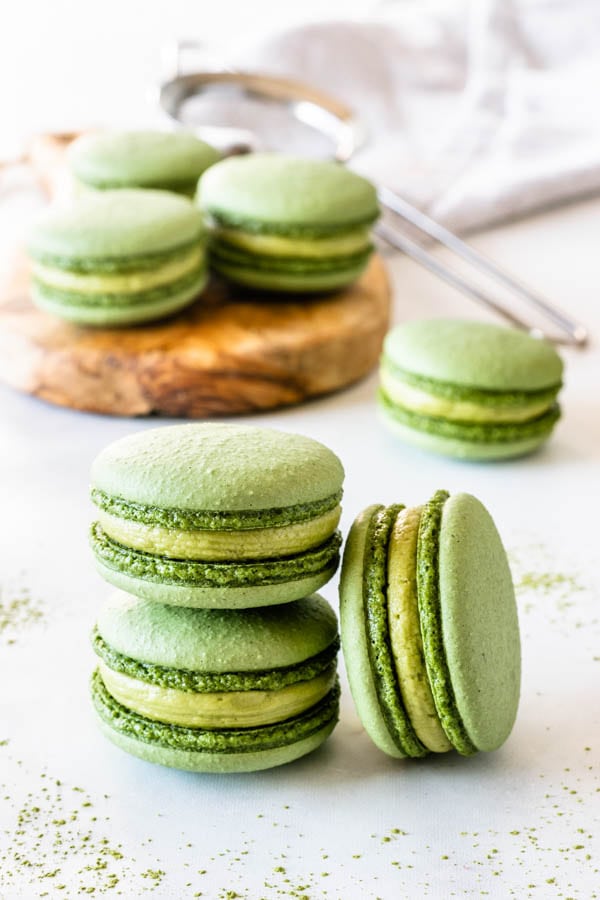
The very first macaron recipe I posted on my blog was for non-vegan Matcha Macarons. Back then, I didn’t bake vegan macarons yet.
When I started learning how to bake vegan macarons, it was like re-learning how to make macarons all over again, since the vegan macarons are also so particular in their own special way.
This post may contain affiliate links. I earn a commission from qualified purchases. Please read our Privacy policy here.
Learning how to make macarons is a big journey. A very personal one too. Some methods that work for some people, might not work for others. And you just have to find your own groove when it comes down to it.
And the way to find your own style, is by practicing, making inevitable mistakes, taking note of what works and what doesn’t, and not giving up!
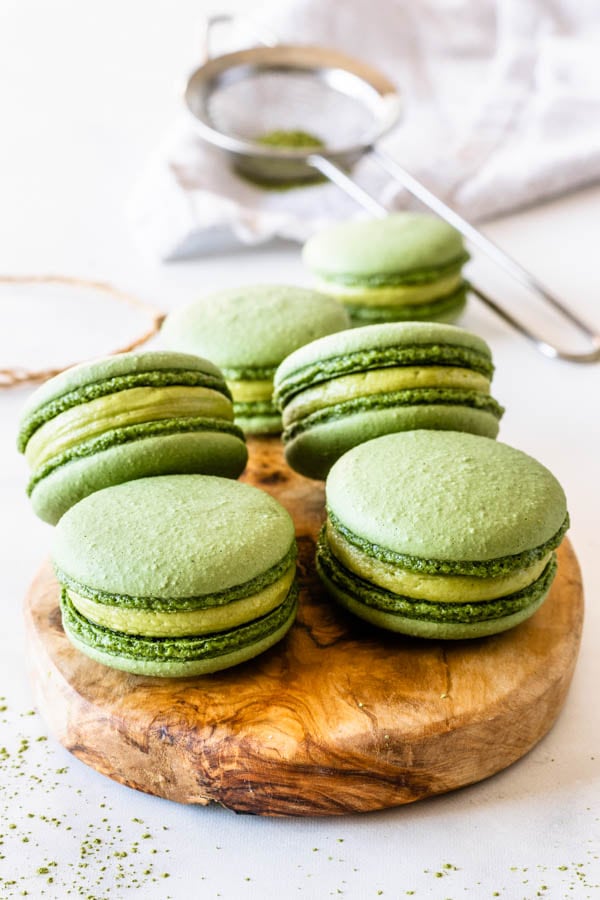
Sounds like motivational talk, and it really is. It’s pretty simple, if you want something, don’t give up on it, believe in yourself, and put love and joy into the mix, because that will make everything happen way faster.
And I am not going to apologize about how cliche this sounds, if you truly understand the meaning of these words with your heart, you will be able to become, have, and do whatever you want in this world.
That being said, I actually have some practical advice today about making Vegan Macarons today on this Vegan Matcha Macarons post. So let’s get to it.
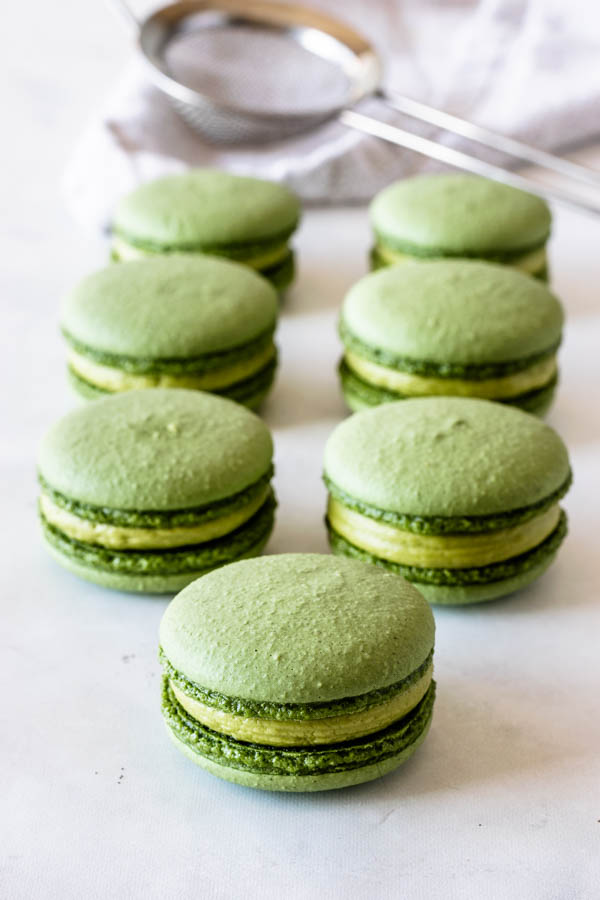
I want to talk about the last step in making macaron shells: the baking part! The actual putting the macaron trays in the oven bit. Let’s go over oven temperature and baking time.
First of all, I will start by saying that you must have an oven thermometer! It’s infeasible to bake macarons without an oven thermometer. They are inexpensive and essential.
I actually have three oven thermometers in my oven. That’s because I like to be able to tell the hot spots in my oven, the difference in temperature between the different areas, plus, when one thermometer breaks, I can easily tell because of how off the temperature will be from the other thermometers.
Now, you don’t need to have three oven thermometers, just one will suffice. But make sure you have one.
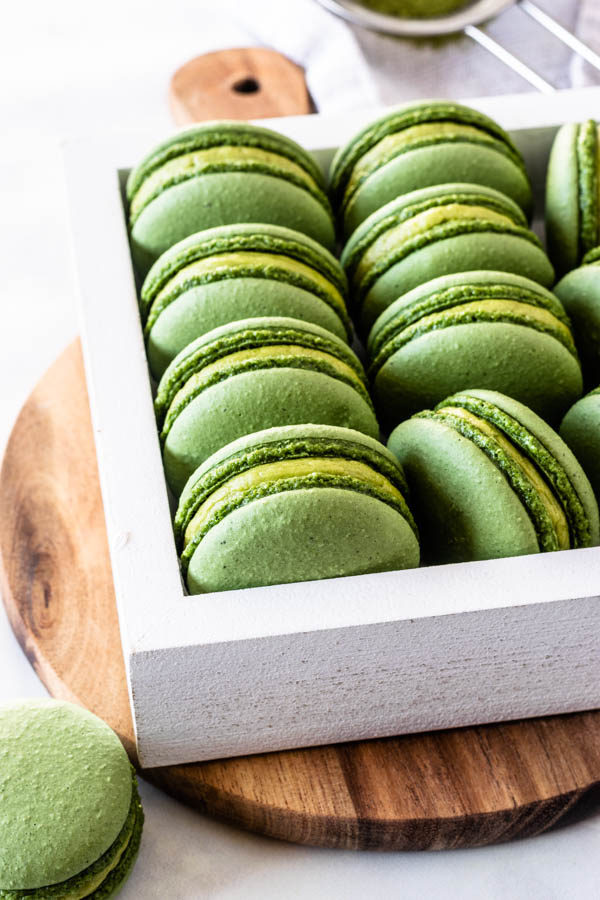
Why is it important mandatory to have an oven thermometer when making macarons?
Home ovens are almost always inaccurate. The oven’s internal thermometer is gauging the temperature of where it’s installed, which is on a spot in the back or sides of the oven, where it’s subjected to drafts or hot spots, so it’s not actually telling the temperature of the inside of the oven, where the macarons are baking.
Plus, ovens cycle on and off in order to keep a stable temperature.
So all these things just mean that the temperature you are setting your oven to, probably won’t be consistent or reliable. The only way to really know and be able to control the oven temperature is to have an oven thermometer in place.
Macarons are very finicky and delicate cookies, and a simple 5 degree difference in the temperature can yield extremely contrasting results.
Here’s the perfect example. The two shells above are from the exact same batch (they are regular non-vegan macarons, but the same applies). The shells on the left were baked at 320ºF and the shells on the right were baked at 325ºF. Look what a 5 degree difference can do to the shells.

And this brings me to the Vegan Matcha Macarons! I made these shells and the batter was slightly wet, I probably folded a big longer than usual. But the batter felt a bit more runny than usual.
I set my temperature at 310ºF as I have been doing, and look at what happened to the shells from the first tray I baked.
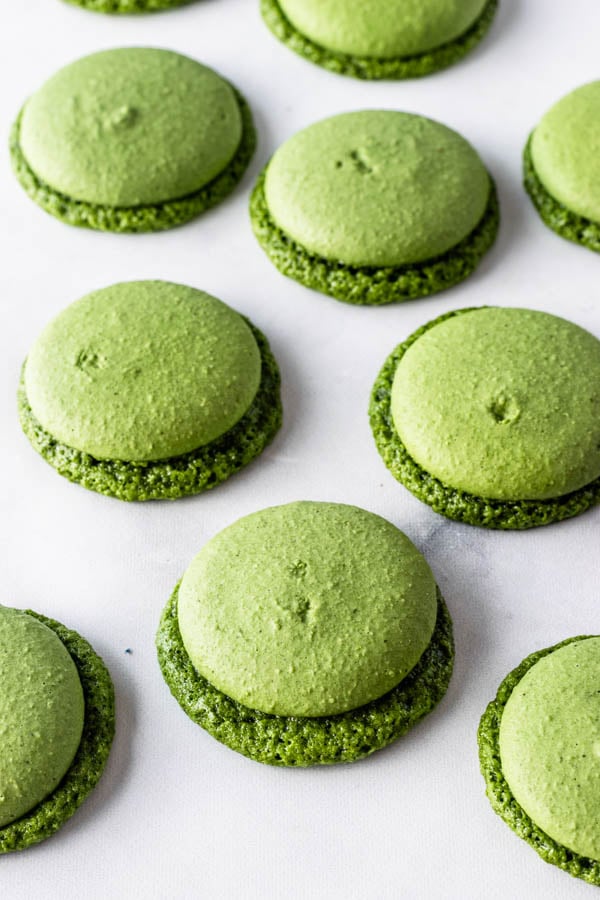
The feet were coming out to the sides. First they got really tall, and then they exploded to the sides as you can see in the picture.
So, for the next tray, I lowered the temperature of the oven all the way down to 280ºF. And I had to bake them for a bit longer, then they turned out beautiful. They were also very full I should say.
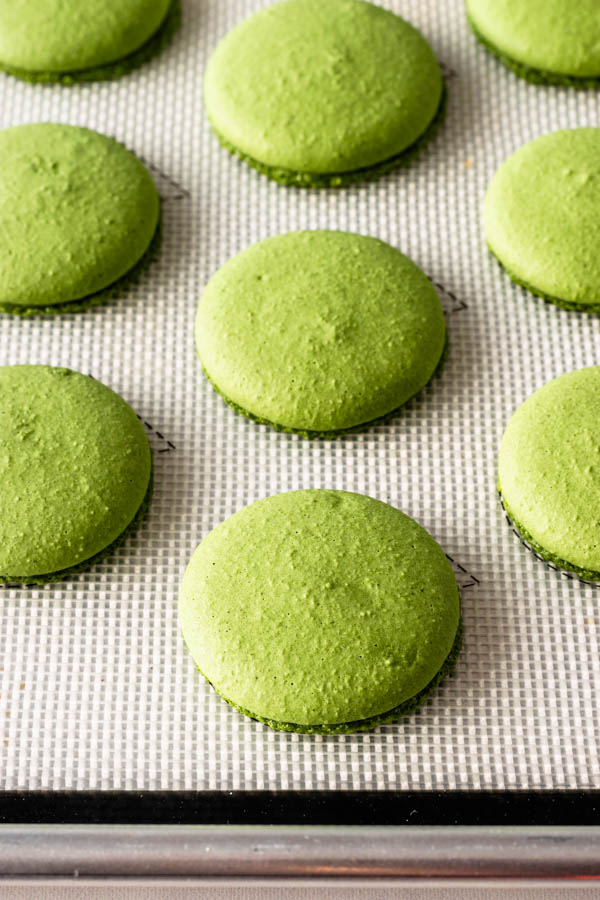
I used to bake my Vegan Macarons at 215ºF, but for the longest time they kept coming out lopsided as you can see below. And that’s when I found out through Megan from Cooking on Caffeine that raising the temperature of the oven to about 310ºF would help solve the lopsided issue.
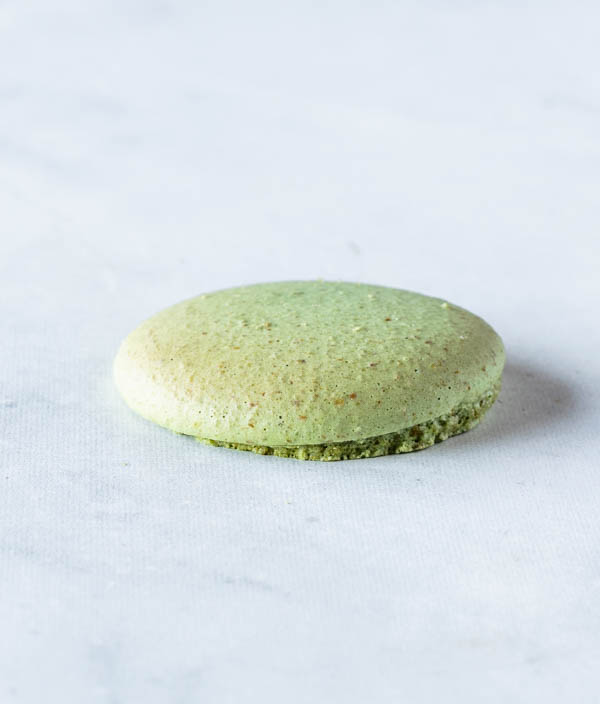
And yes, it did solve my issues for a while, until I encountered this batch of Vegan Matcha Macarons, which demanded a lower temperature than 310ºF.
So here is what I suggest.
Temperature
When baking macarons, if you notice the macarons are starting to crack in the oven, or develop huge exploding feet, try lowering the temperature for the next tray.
Those are signs of over mixing the batter, or under whipping the meringue as well, but if the batter wasn’t too over mixed, there might be a chance of fixing the next tray by lowering the temperature.
And if you are pretty sure of your meringue and macaronage techniques, it might be worth examining what issues could be going on with your oven.
To do that, simply pipe the macaron batter between 4 different trays. Bake each tray at a different temperature, playing around and lowering and raising the temperature. At the same time, track with your oven thermometer, and make notes of the results you get with each different temperature and tray.
Rack position
It might also be worth playing around with the rack position in the oven, by lowering or lifting it up. I bake with my rack in the middle always, and that has worked for me, but I’ve heard of people who bake on the lowest rack, or highest, depending of where the heat source is coming from.
Baking trays
Darker baking trays will absorb more heat, therefore you might have to lower the oven temperature if you are getting cracked macarons or exploding feet.
Also consider using a double tray for the macarons if you are finding the heat is too much coming from the bottom of the oven.
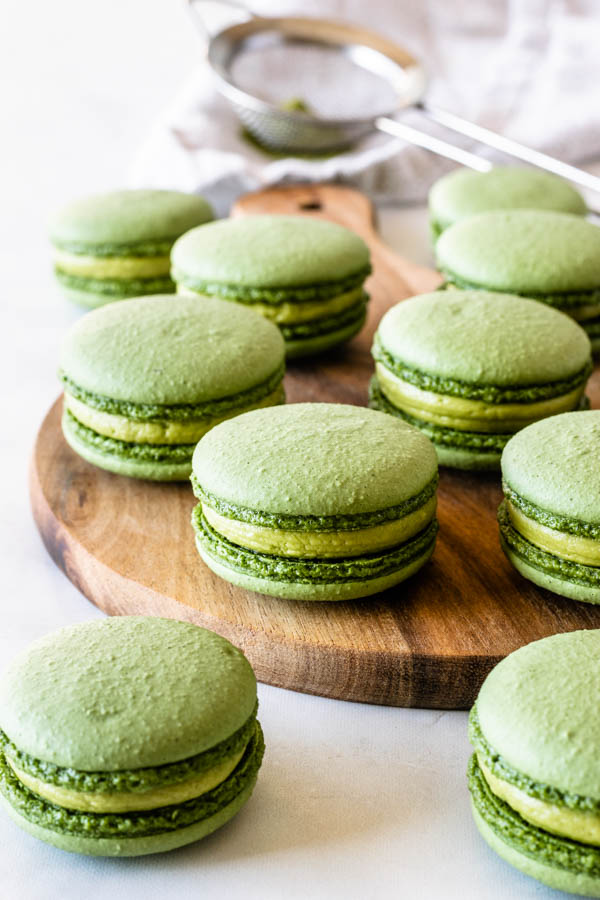
The reason why I know all of this tips and tricks, is because I have been baking macarons for quite some time, I’ve made lots of mistakes. I am also part of wonderful Facebook groups, where the members exchange lessons, advice, tips, and I am always learning so much from everyone.
Plus, I always have people send me pictures of their failed batches for troubleshooting, and while I try to help them figure it out, it is also great learning for me to follow along the journey of some bakers as we try to tackle their macaron issues. I mean, I have literally baked batches with people over messages before!
It’s such a joy to be able to do this as my job: help and teach people how to bake macarons and make fantastic desserts! I am really fulfilled doing something so cool that I love so much! And the only way I was able to have this be my job, is because I didn’t give up, I believed in myself, and I didn’t see any other way besides to keep going. Which was my very cliche advice from the beginning of the post, and look where it brought us!
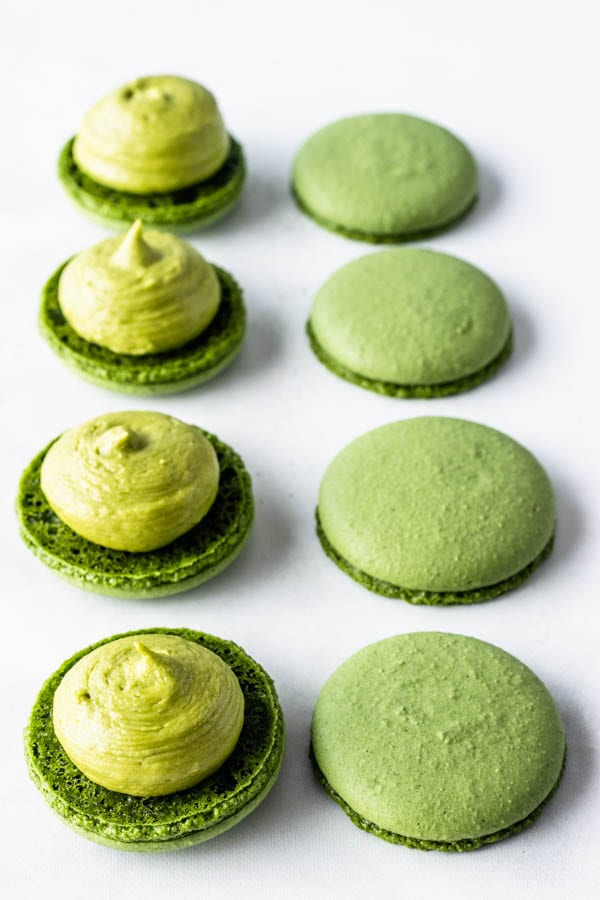
Here are some other Vegan Macaron ideas if you enjoyed these Vegan Matcha Macarons:
- Vegan Coffee Macarons
- Vegan Vanilla Macarons
- Vegan Avocado Macarons
- Vegan Raspberry Macarons
- Vegan Salted Caramel Macarons
- Vegan Biscoff Macarons
- Vegan Pistachio Macarons
And I also have some videos on my youtube channel, where I show the whole process of making vegan macarons.
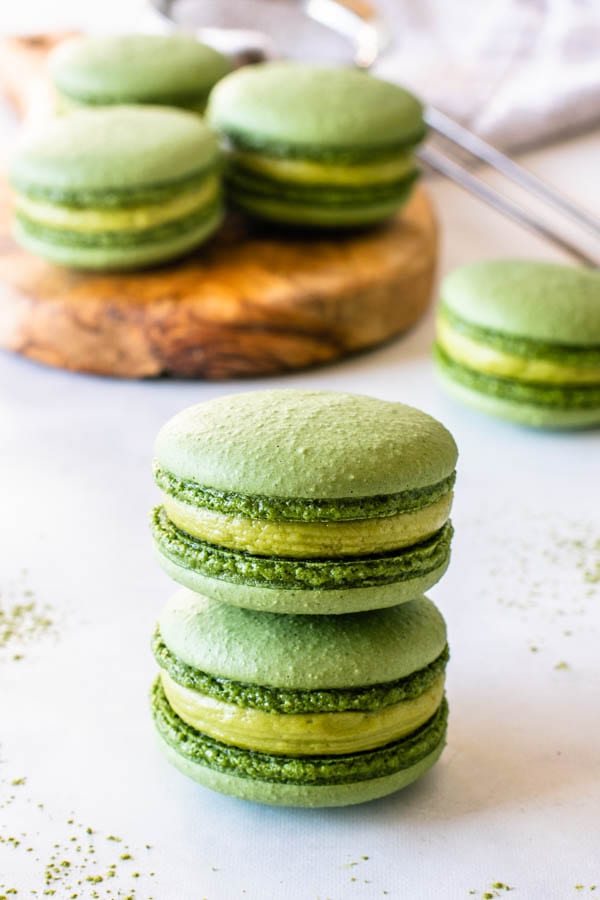
I hope you enjoyed my tips on how to make vegan macarons today, and I hope I could help you a bit on your own journey! Send me any questions or troubleshooting, I’ll be happy to help!
Have a great day!
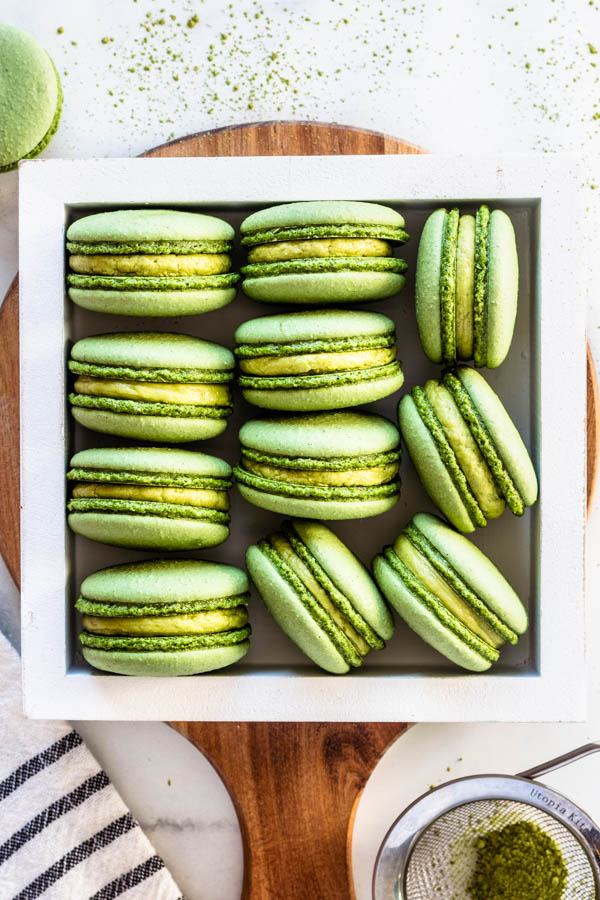
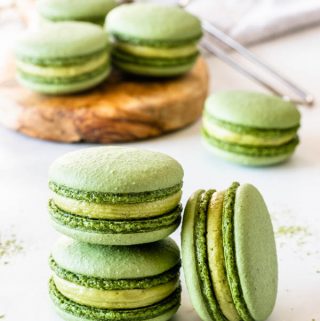
Vegan Matcha Macarons
Ingredients
Vegan Macaron Shells
- 1/3 cup reduced aquafaba from 3/4 cup of chickpea brine* 70 grams
- 110 grams almond flour
- 107 grams powdered sugar
- 1/2 tablespoon matcha powder 3 grams
- 1/4 teaspoon cream of tartar
- 66 grams granulated sugar
Vegan Matcha Buttercream
- 1/2 cup vegan butter 113 grams, 4 oz*
- 1 cup powdered sugar 127 grams, 4.5 oz
- 1 teaspoon of matcha powder or more it’s up to how strong you’d like your buttercream to be
Instructions
Vegan Macaron Shells
- Start by placing 3/4 cup of chickpea brine (150 grams) (water drained from a chickpea can) in a small saucepan. Let it simmer for 5-10 minutes to reduce to about 1/3 cup (70 grams).
- Place it in the fridge for a few hours or overnight to let it get thick. It will have egg white consistency.
- Gather all of your ingredients before starting to make macarons. Measure out all ingredients. Line two baking sheets with silicon mats. And fit a large piping bag with a round tip. You want everything ready to go when you need it.
- Sift almond flour, powdered sugar, and matcha powder together. Set aside.
- Place 1/3 cup of the reduced and cooled aquafaba in the bowl of a mixer with the cream of tartar.
- Whip for about 1 minute on low, or medium low if the low on your mixer is way too slow. (On my hand mixer I whip on low, but on my KitchenAid I whip on medium low)
- At this point, raise speed to medium, and whip for another 2 minutes.
- Raise speed to high and start to add granulated sugar, slowly, a bit at a time.
- Continue to whip until the aquafaba achieves stiff peaks.
- The whole whipping, from beginning to end, should last about 10 minutes, but sometimes it may last longer. Make sure you have obtained stiff peaks, shooting straight up.
- Add sifted dry ingredients to whipped aquafaba. Start folding with a spatula slowly.
- Add food coloring at this point, if using any.
- Fold forming a letter J with the spatula.
- Fold until the batter is flowing slightly. You don’t want the batter to be flowing continuously off the spatula. When it comes to vegan macarons, the folding time is very very brief. You are basically just looking to incorporate the dry ingredients with the meringue. Please watch the video to see what the consistency should look like. If you grab a spatula full of batter and hold it over the bowl, it should still be separating in chunks, and not flowing continuously on a ribbon. Do not get to the ribbons stage! If you get to the ribbon stage, the macaron feet will spread out in the oven.
- Transfer batter to the piping bag.
- Pipe 1 1/2” circles on a baking sheet lined with silicone mat. I usually use 2 sheets. This will depend on how big you pipe your macarons.
- Slam the trays against the counter to release air bubbles.
- Use a toothpick to pop any remaining bubbles.
- Let trays rest for 30-45 minutes until the shells are dry. Test this by touching a macaron gently with your finger. Depending on humidity levels and weather, it might take longer or less time for your macarons to dry.
- Pre-heat oven to 310F.**
- Bake each tray separately.
- Bake for a total of 20 minutes, or until the macarons are easily coming off the silicon mat.
- Remember to rotate the tray every 5 minutes, to ensure even baking.
- Baking time might vary depending on your oven.
- Let macarons cool down before filling.
Vegan Matcha Buttercream
- Cream the butter for 30 seconds.
- Sift powdered sugar and matcha powder. Add to the butter. Cream until creamy.
- If the mixture is too stiff, add a teaspoon of non-dairy milk to adjust the consistency.
- And if the buttercream is too runny, add a bit more sifted powdered sugar until you obtain the perfect consistency, which should be creamy, fluffy, and smooth.
To assemble
- Place Vegan Matcha Buttercream in a piping bag fitted with the tip of choice. Pipe some buttercream in half of the shells. Top with another shell. Let the macarons mature in the fridge for 1 day before serving.
Storage
- Store the macarons in the fridge for up to 1 week, or in the freezer for up to 2 months.



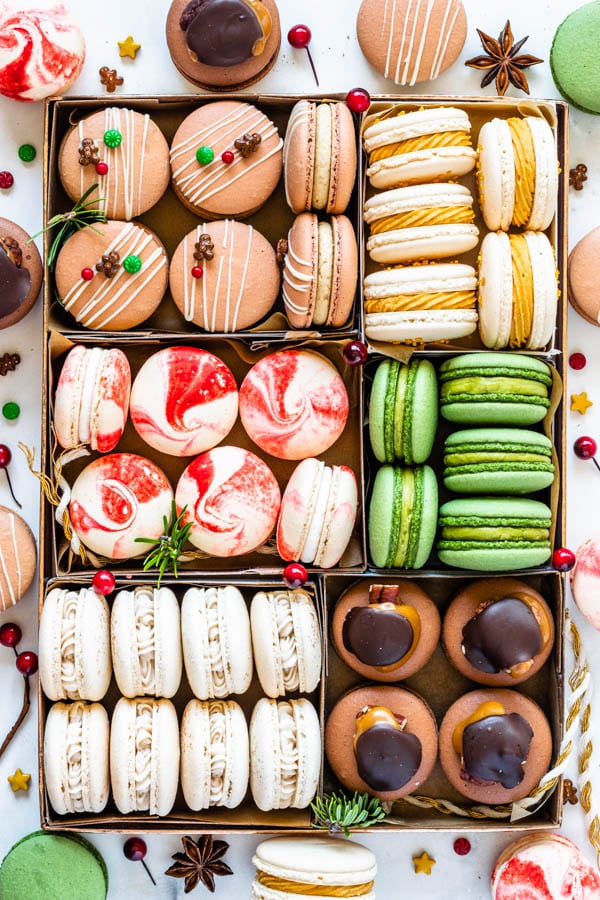
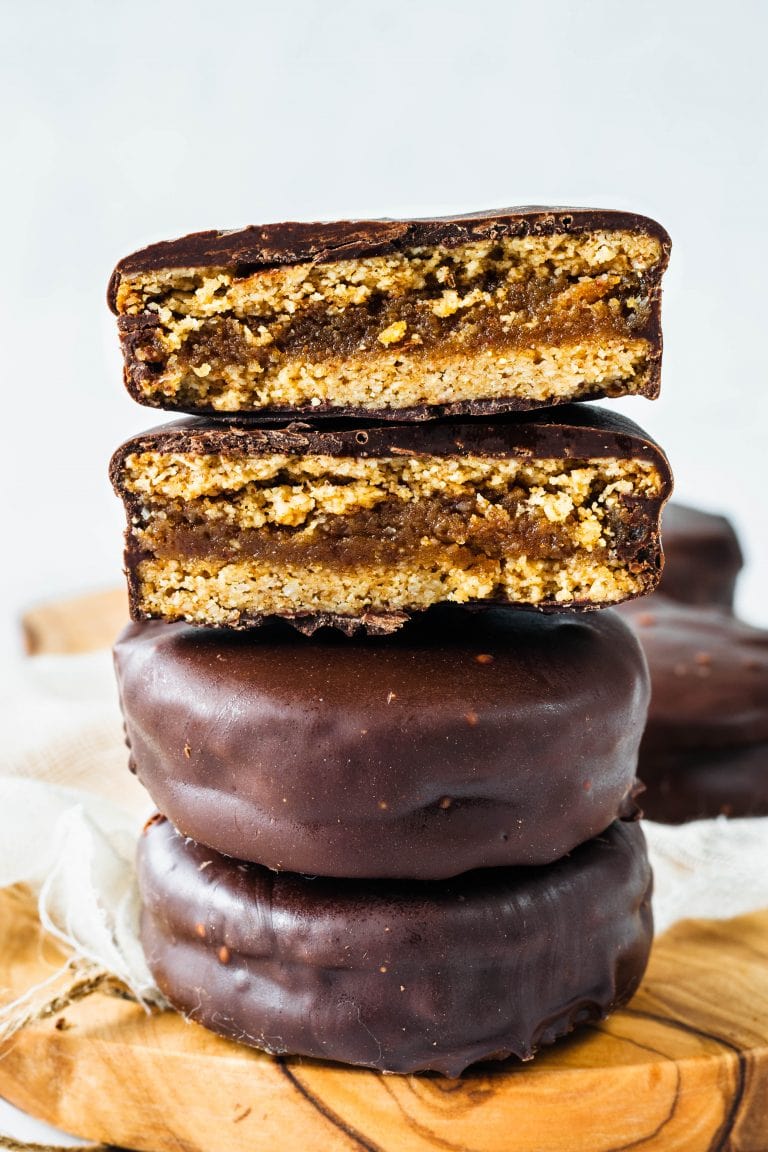
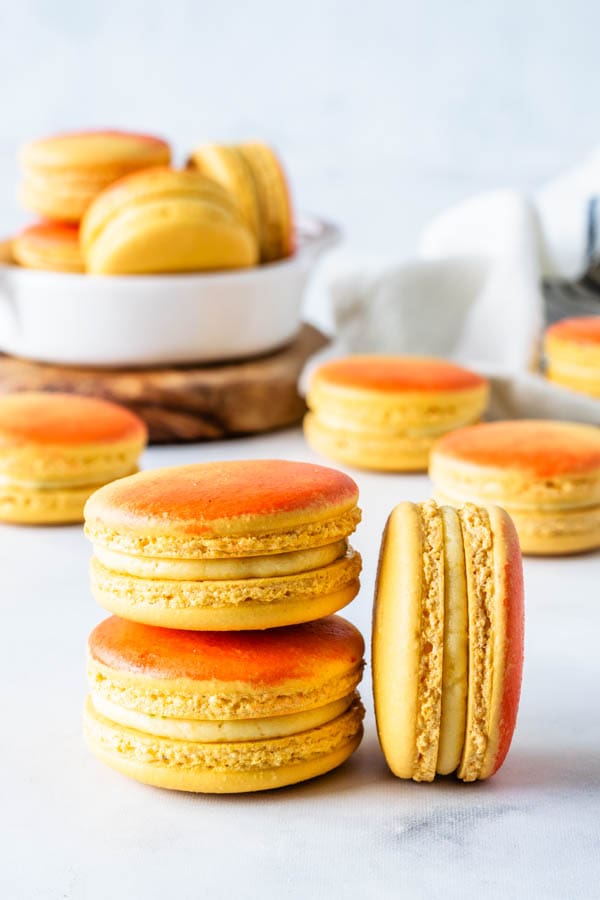

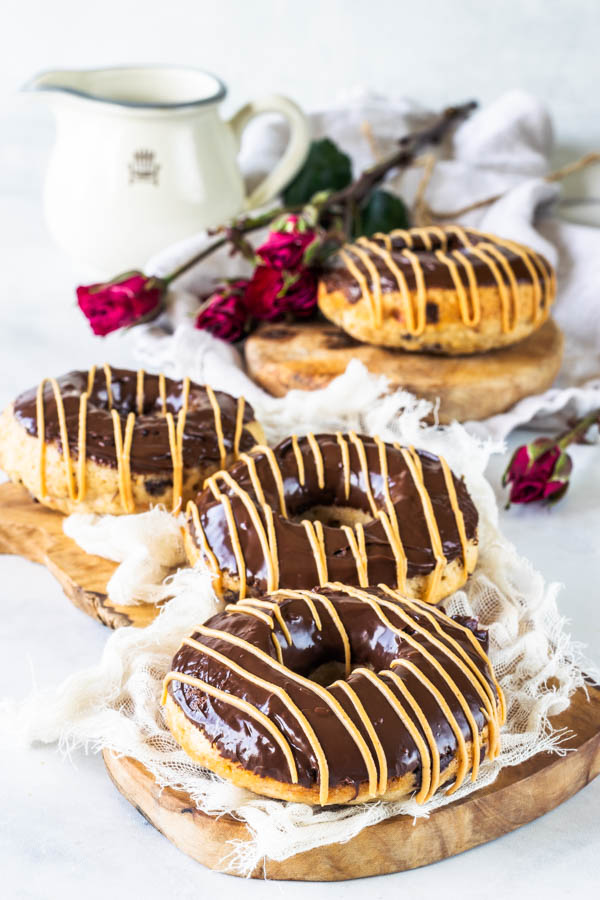
Esses macarons ficaram muito gostosos, maravilhosos!!!!!!
It’s fun to watch the evolution of your macs to the perfect ones you bake today. I have had 6 failures and 1 success but the successful ones, even though I had beautiful even feet and perfect smooth tops, were A tiny bit hollow right under the shell. Not the whole she’ll just the top part. I have tried turning heat up using Megan’s recipe and it was way too hot my feet exploded. The only almost perfect success was baking on 275 f. What do I think causes half of shells to be hollow?
Thank you so much Debbye! Lately I’ve baked mine at 280F also, because the feet started to explode. So you never know with the macs, always got to experiment.
The shells being hollow could be soooo many reasons!
it usually happens to my vegan macarons when I overbake them. They become crunchy and hollow.
Baking slightly less than I was used to has helped with it a lot.
Overwhipping the meringue could cause hollows, which is the cause for most of the hollows I get with my regular non vegan macs, but I’ve heard this could be a culprit for the vegan ones too.
Humidity could be a culprit. High heat also.
Anyway, just so many factors, it’s hard to pin point what happened exactly without being there in your kitchen with you.
But knowing these factors now, maybe you can access next time. Like for me, and many people, the culprit is usually over baking them.
Thank you again Debbye! Have a great day!!!
Dear Camila, thank you so much for posting all these amazing recipies! 🙂 Your blog is awesome! I would like to try baking vegan macarons. Is the cream of tartar essential for good baking results? I am from Germany and it’s not that easy to find cream of tartar here. Could I replace it with some sort of cream stiffener?
Again thanks so much. Best regards! Anna
Typically you can substitute vinegar for cream of tartar, however, some people report having issues with adding vinegar, while others thrive on the substitution. You could also not add vinegar or cream of tartar at all, as I also know of people who don’t add them either. It’s all a matter of experimenting. I would try without vinegar first, and if you find the meringue too unstable try it with vinegar on the second time around! Let me know how it goes! If you have any questions feel free to send any messages.
Thank you for your kind words!! Have a lovely day!
Thanks so much for your quick reply! 🙂 I will let you know how it worked out as soon as I’ve tried it out. 🙂 Do you also have a recipe for vegan chocolate macarons? Best wishes!
Hi Camila, so what temperature do you want your oven thermometer to read? I’ve had exploded feet at 310, 285, and even 250 lol. Trying to figure this out! I tried mixing less (and some of the tops cracked like it was undermixed) and the others still had frilled out feet!
Hi Camila,
I only have a convection oven. Will I be able to make macarons? I can still buy an oven thermometer, but I jsut wanted to know what your thoughts were on the convection oven.
Yes, you can either try with the fan off, or just lower the temperature by at least 10% of what I recommend. Regardless you will have to experiment with the temperatures to find the best one for your oven.
Hi you!! thank you for this recipe and all your advice. I tried several times and I can’t get full macarons. Mine are empty. yours looks so nice but are they full or empty like a little cave???
Thank you for your reply.. I can’t wait.
try adding 1/4 tsp of xantham gum to your meringue
I saw your tip to just use Aquafaba straight from the can. Does that change the amount needed in the recipe or just 70g unreduced?
same measurement, just unreduced.
Hi Camille , I follow your you tube vegan macaron recipe and followed your advise on baking them in. 4 different batches. My feet’s came finally with a temperature of 120•c but when I removed them , to my horror they all were hollow from inside, no matter what temperature I baked them. And the feet’s are sticky from inside and they separate from top. Plz help. I whipped my home made aquafaba meringue with cream of tartar for 20 minutes to get to stiff peaks and I folded my batter only till it reached ribbon consistency but no figure of 8 was forming .
I find a huge issue with homemade aquafaba, because you cant necessarily get it to the same concentration of the canned. Some people do make it with homemade aquafaba, but it takes a lot of trial and error with the type of aquafaba concentration itself to nail it. Because even if it gets to stiff peaks, it will still bake differently.
Hello! Thank you for the recipes! I bought your book yesterday and it’s amazing but I’m.coming here for your vegan recipes:) could you please share which vegan butter are you using? Mine comes our too runny even if I add way more conf sugar 🙁
Ive used myokonos, and even earth balance. make sure the butter is cold
Will try! Thank you! You’re inspiring!!
Gostoso, saudável e nutritivo!! Tudo de bom!!